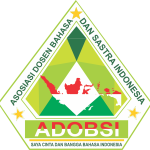Semiotics Study of Structure and Meaning in Javanese Lullaby Song “Tak Lela-Lela Ledhung”
Abstract
This study aims to describe the structure, semiotic meaning, and life values of Javanese people in lullaby songs. The data in this study is the text of a lullaby entitled Tak Lela-Lela Ledhung. The analysis is focused on the structure of the song Tak Lela-Lela Ledhung using the Halliday &Matthiessen theory. Semiotic analysis with Peirce's theory includes three aspects, namely sign, object, and interpretant. The representation of the value of life in the song is also presented to enrich the results of the analysis. The results of this study show that in the textual aspect, structural elements in Tembang Tak Lela-Lela Ledhung involve the use of inter-sentence relationships in the form of lexical cohesion and grammatical cohesion. Based on Peirce's semiotic analysis, the song Tak Lela-Lela Ledhung has a tendency to have constructions formed from the daily lives of Javanese people. In the lyrics of the song, advice is implied in the form of prayers and parents' hopes for their children's future. The values found are patience, hard work, and the will to fight for the future.
Keywords
Full Text:
PDFReferences
Arum, D. P. (2020). Lelo Ledhung: Representation of character education values in Javanese lullabies for children. Proceedings of the National Seminar on Elementary Education (CES), January 2020, 186–192. Surabaya, Indonesia: Universitas Muhammadiyah Surabaya.
Badan Pengembangan dan Pembinaan Bahasa. (2016). Kamus Besar Bahasa Indonesia (Edisi ke-4). Jakarta: Kementerian Pendidikan dan Kebudayaan Republik Indonesia. Retrieved from https://kbbi.kemdikbud.go.id/
Bambang, M., & Nur, E. (2013). Semiotics in communication research methods. PEKOMMAS: Journal of Communication, Informatics and Mass Media Research, 16(1), 73–82. https://doi.org/10.30818/jpkm.2013.1160108
Culler, J. (1996). Ferdinand de Saussure. Ithaca, NY: Cornell University Press.
Danandjaja, J. (1986). Indonesian folklore. Jakarta: Pustaka Utama Grafiti.
Merriam-Webster. (2002). Merriam-Webster online dictionary. Retrieved from https://www.merriam-webster.com/
Dwijawiyata. (2001). Tembang dolanan (Titilaras Solmisasi). Yogyakarta: Kanisius.
Endraswara, S. (2005). Metode dan teori pengajaran sastra: Wawasan kurikulum berbasis kompetensi. Yogyakarta: Pustaka Widyatama.
Endraswara, S. (2009). Metodologi penelitian folklor. Yogyakarta: Media Pressindo.
Farida, A., et al. (2016). Tembang dolanan: A reflection of Javanese philosophy. Semarang: Balai Bahasa Jawa Tengah.
Halliday, M. A. K., & Matthiessen, C. M. I. M. (2013). Halliday’s introduction to functional grammar (4th ed.). London, UK: Routledge. https://doi.org/10.4324/9780203431269
Layli, N. (2020). Makna lirik lagu Lingsir Wengi karya Sunan Kalijaga (Analisis semiotika Roland Barthes) [Undergraduate thesis, IAIN Ponorogo]. Ponorogo, Indonesia: IAIN Ponorogo Repository.
Marhandra, R. (2020). Sumbawa oral traditions: Ethnographic study of communication. Lombok Barat, Indonesia: Rehal Publisher.
Mulyana, D. (2005). Kajian wacana: Teori, metode dan aplikasi analisis wacana. Yogyakarta: Tiara Wacana.
Murniati, T., Restuadhi, H., & Handoyo, R. (2022). The portrayal of Javanese women in Waljinah's selected songs: A hermeneutics study. In Proceedings of the 1st International Conference on Gender, Culture and Society (ICGCS 2021) (pp. 1003–1014). Paris, France: Atlantis Press. https://doi.org/10.2991/assehr.k.220102.123
Nazir, M., & Sikumbang, R. (2013). Metode penelitian. Jakarta: Ghalia Indonesia.
Nugrahani, F. (2014). Metode penelitian kualitatif. Surakarta: Cakra Books.
Parmono, K. (2013). The value of local wisdom in traditional Kawung batik. Jurnal Filsafat, 23(2), 134–146.
Peirce, C. S. (1931). Nothing is a sign unless it is interpreted as a sign. In C. Hartshorne & P. Weiss (Eds.), Collected papers of Charles Sanders Peirce (Vol. 2, p. 308). Cambridge, MA: Harvard University Press.
Poerwadarminta, W. J. S. (1939). Baoesastra Djawa. Batavia: J. B. Wolters.
Prasad, B. D. (2008). Content analysis. In D. K. Lal Das & V. Bhaskaran (Eds.), Research methods for social work (pp. 173–193). New Delhi, India: Rawat Publications.
Ramlan, M. (1993). Paragraf: Alur pikiran dan kepaduannya dalam bahasa Indonesia. Yogyakarta: Andi Offset.
Rhomah, M. (2018). Semiotic analysis of the lyrics of dolanan songs in collections DVD of children's songs. Bening: Student Research Journal of Javanese Language Education Study Program, 7(3), 45–52.
Saptawuryandari, N. (2017). Semiotic analysis of Chairil Anwar's poetry. Kandai, 13(1), 95–104. https://doi.org/10.26499/jk.v9i1.286
Saputra, D., Sos, S., & Saifuddin, A. (2022). Semiotic analysis of film. Jakarta: Main Haura.
Setyaningsih, N. R. (2015). The cultural meaning of Tembang Tak Lela-Lela Ledhung: An ethnolinguistic review. Procedia – Social and Behavioral Sciences, 159, 100–105. https://doi.org/10.1016/j.sbspro.2014.12.345
Refbacks
- There are currently no refbacks.






